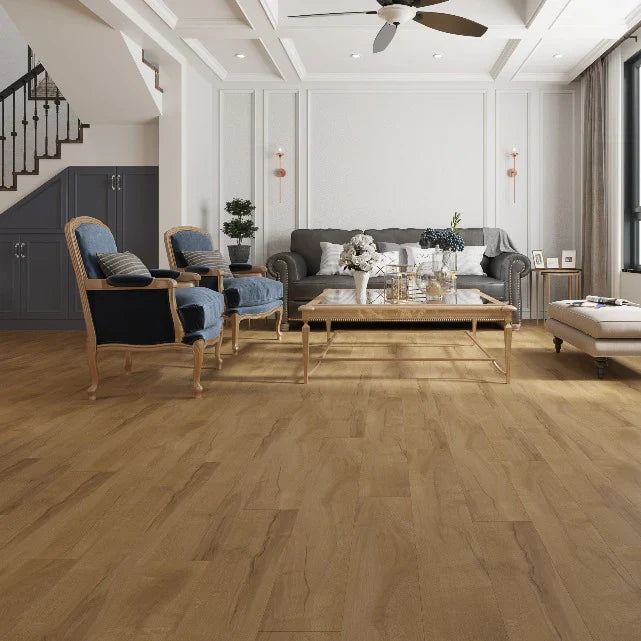
Author, Written by: P. Hirani (Wood flooring Expert)
Sustainability is more than just a trend in the UK : it is a growing lifestyle choice. From energy saving appliances to locally sourced materials, British homeowners are rethinking how their homes impact the planet. One area where this shift is especially noticeable is in flooring. More people are now choosing eco-friendly flooring options that offer both style and environmental responsibility.
Whether you are renovating a period home or designing a new build, there's an eco-conscious flooring solution to suit every aesthetic. Below, we explore the most popular sustainable flooring options in British homes and what makes them an environmentally smart choice.
1. Engineered Wood Flooring
Engineered wood is one of the most sought after flooring types for its natural beauty and long lifespan. What makes it eco-friendly is its efficient use of hardwood: only a thin top layer is made of real timber, while the base is constructed from fast growing, renewable wood like birch or poplar.
Why it's sustainable:
-
Uses less slow growing hardwood compared to solid wood
-
Compatible with underfloor heating, reducing energy use
-
Available from FSC and PEFC certified sources
Many British households favour engineered oak in brushed or smoked finishes for a rustic yet modern touch.
2. Cork Flooring
Cork is harvested from the bark of cork oak trees without harming the tree, making it one of the most renewable flooring materials available. It’s soft underfoot, naturally antimicrobial, and provides excellent insulation perfect for British homes looking to stay warm in winter.
Why it's sustainable:
-
Bark regrows every 9–10 years
-
Biodegradable and recyclable
-
Low VOC (volatile organic compounds) levels
Cork’s natural texture suits Scandinavian and minimalist interiors, and it is available in tiles or planks with a variety of finishes.
3. Bamboo Flooring
Bamboo grows significantly faster than traditional hardwoods some species can reach maturity in just five years. It is durable, water resistant, and ideal for households that want the look of timber without the environmental impact of slow growing forests.
Why it's sustainable:
-
Rapidly renewable
-
Lower carbon footprint than imported hardwoods
-
Often manufactured using low VOC adhesives
Look for strand woven bamboo options, which are denser and harder than many hardwoods, and check for responsible sourcing certifications.
4. Reclaimed Wood Flooring
Reclaimed wood is salvaged from old buildings, barns, and industrial sites, repurposed into stunning floorboards full of character. This is a popular choice for homeowners who want a vintage or rustic look while reducing their reliance on new timber.
Why it's sustainable:
-
No new trees are cut down
-
Reduces landfill waste
-
Adds historical charm and uniqueness
Reclaimed pine and oak are commonly used in British period homes, often finished with natural oils or hard wax for an authentic look.
5. Natural Linoleum (Not to Be Confused with Vinyl)
Linoleum is made from linseed oil, wood flour, and other renewable materials. While often confused with synthetic vinyl, natural linoleum is a completely biodegradable product that has been used in British homes for over a century.
Why it's sustainable:
-
Fully biodegradable
-
Made from renewable raw materials
-
Naturally resistant to bacteria
It is available in rolls and tiles in a wide range of colours, from earthy tones to bold modern shades, making it a versatile option for kitchens and hallways.
6. Eco-Friendly LVT (Luxury Vinyl Tile) Options
While traditional vinyl isn’t the greenest choice, newer LVT options are emerging with improved eco credentials. Some brands now offer LVT made from recycled content and manufactured using cleaner processes, helping to reduce emissions and plastic waste.
What to look for:
-
Products with high recycled content
-
Brands committed to take back schemes or cradle to cradle manufacturing
-
FloorScore or similar indoor air quality certifications
LVT remains a practical choice for busy UK households thanks to its durability and low maintenance, especially in kitchens and bathrooms.
Making the Right Eco-Friendly Choice
When choosing sustainable flooring, it is important to think about more than just the materials. Look for:
-
Third party certifications (FSC, PEFC, FloorScore)
-
Local suppliers to reduce transport emissions
-
Low VOC finishes and adhesives
The right eco-friendly flooring not only supports the environment but also creates a healthy, stylish living space. Whether you’re drawn to the warm tones of reclaimed oak or the resilience of bamboo, sustainable flooring is no longer a compromise : it is a smart, lasting investment in your home and the planet.
About Author:
Peter H. is a flooring product expert who knows all about different types of flooring materials. He shares his knowledge in blogs to help readers make the best choices for their spaces.
